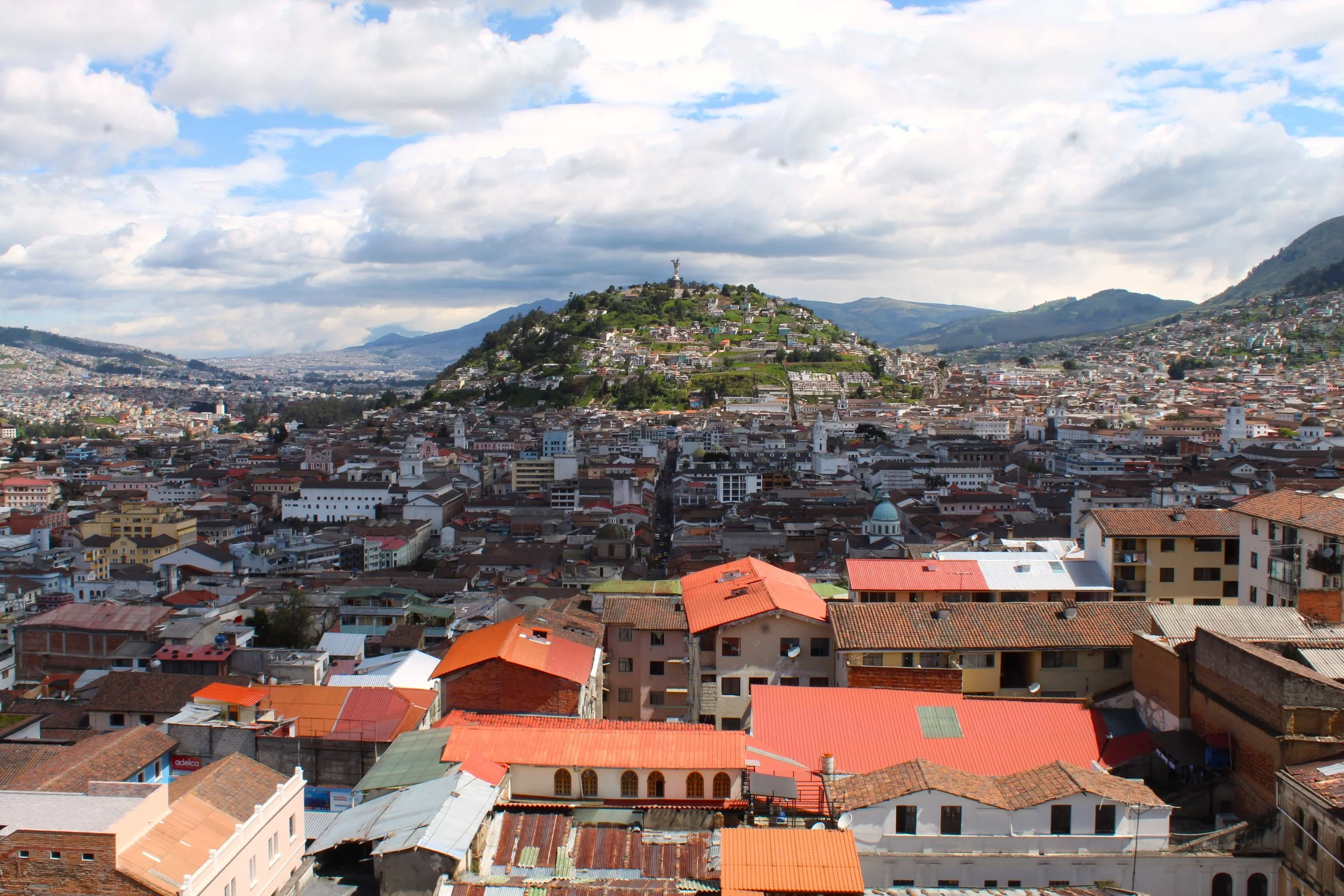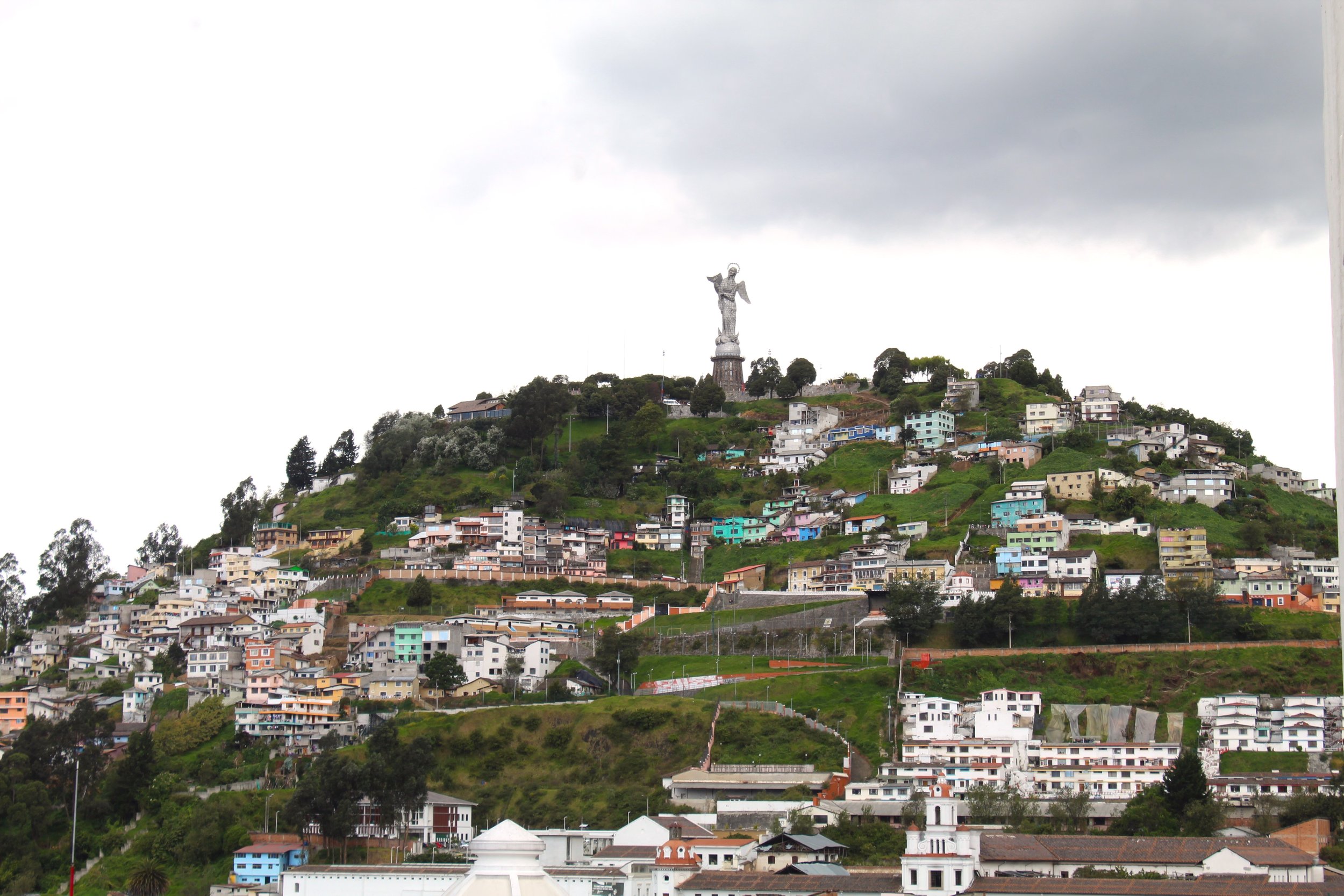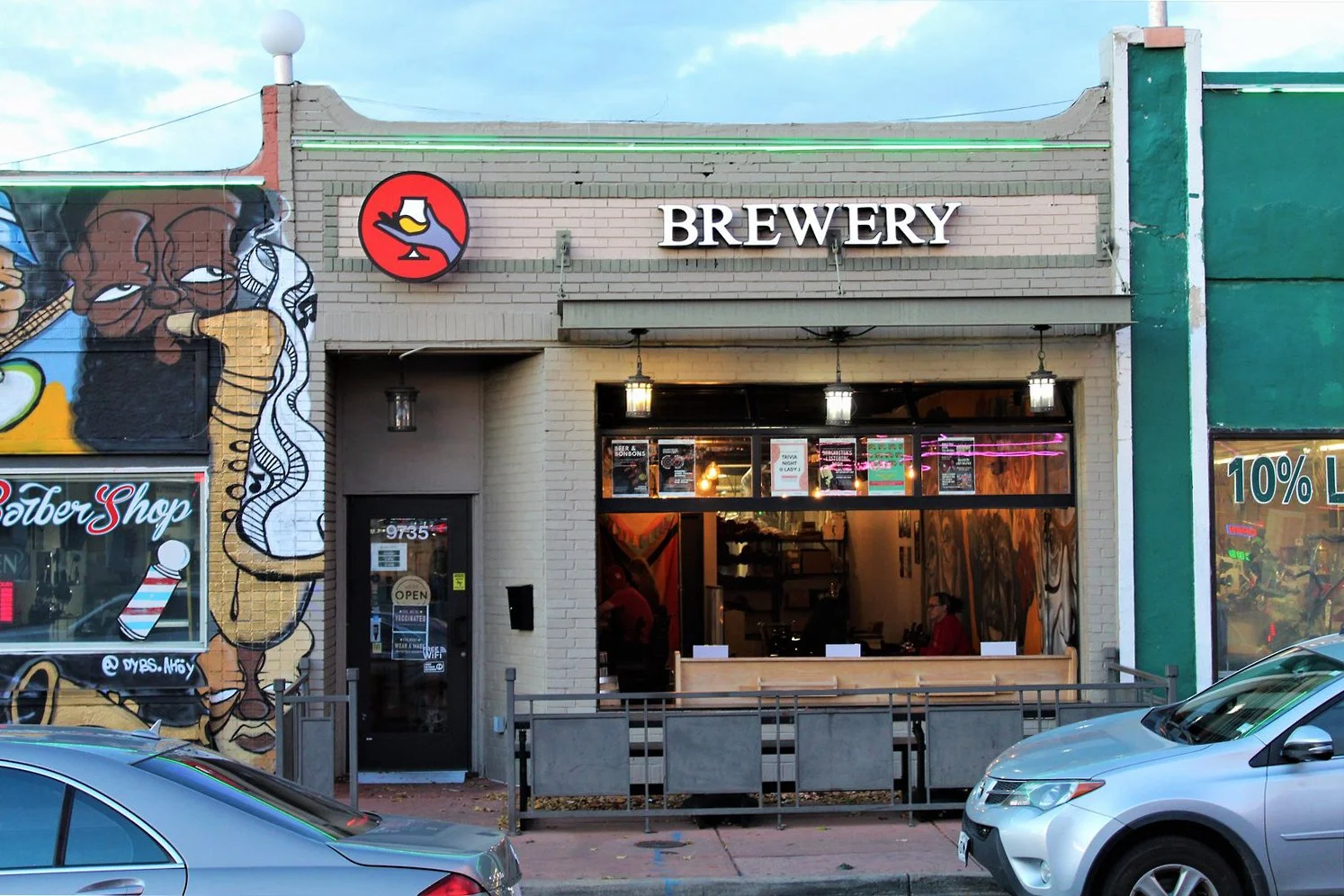El Mitad del Mundo — Beer, Chicha, and the Intersections of Old and New in Quito, Ecuador
Quito is a city at the centre of the world and the intersection of multiple identities. The Ecuadorian capital straddles hemispheres, its northern point pierced by the lateral line of the equator. It sits suspended between ocean and sky, its elevation almost exactly halfway between sea level and the highest peak of the Ecuadorian Andes. And—as so many cities throughout Central and South America do—it finds itself culturally negotiating the modern space between its Indigenous heritage and the changes often violently wrought by colonialism over the past five centuries.
The city is poured into a meandering valley on the eastern slope of the Pichincha volcano, spilling outward into canyons and draping over ridges; the effect is that any part of it you’re in feels like the only Quito there is. The true cultural centre of the city though is the Centro Historico, with buildings dating back to the 16th century. The neighbourhood sits in a basin, cradled around its northwestern flank by the volcano and its neighbours, separated from the modern end of the city by a decrescendoing ridge of the mountains to the northeast, and abutted to the southwest by a rounded hill called El Panecillo—‘Little Bread Loaf’—topped by a 135 foot (41 metre) statue of the holy virgin vanquishing a dragon.
In the heart of Centro Historico is the church and convent of San Francisco, the largest architectural complex within any historic centre of South America. Construction on the compound began in 1537, but was not completed until 1650. Pigeons glide and sweep in arcing flight around the expansive square at the foot of the structure, landing when a tourist seems amenable to sharing snacks. The city’s ubiquitous feral dogs lounge in the shade, and a single carousel horse sits alone on the cobblestones, a misplaced relic.
Photography by David Nilsen
It is here in the San Francisco Plaza where the brewing traditions that have shaped Quito’s modern beer scene come together. Tucked into a back corner of the convent is an antique brewery (known as the Antigua Cerveceria Franciscana) first established by Flemish monk Jodoco Ricke in the year 1566, considered by most to be the first European brewery in the Americas. Just a few doors down a side street off the plaza sits Casa del Alabado, a museum filled with the nation’s archaeological treasures, including numerous vessels for serving and ritually offering chicha, the Indigenous corn-based beer that preceded—and survived—the arrival of Europeans. And on one corner of the square, through a stone archway, is the thriving taproom for Sinners Microcerveceria, one of the city’s many modern craft breweries. The strong cord of Quito’s brewing scene is woven with these threads—Indigenous tradition, colonial change, and modern innovation.
Here in el Mitad del Mundo—the middle of the world—the old and new can be tasted side by side.
***
Any story of brewing in Ecuador must begin with chicha, an Indigenous brewing tradition that long predates the arrival of European brewing techniques to the region. Brewed with corn (or occasionally other starches, such as manioc root), chicha is most commonly associated with Peru by North Americans and Europeans, but these national borders didn’t exist when indigenous people groups first started making alcoholic beverages millennia ago from this sacred crop. Sensational (and less than responsible) reporting over the years has led to the misguided belief in North America that making chicha did and does involve masticating corn to enzymatically convert its starches into fermentable sugars; in reality, Indigenous groups have understood how to malt corn for centuries, no chewing required. In the face of colonialism and cultural change, chicha has held on.
At Museo Casa del Alabado on Calle Cuenca, some of the significance of chicha throughout Ecuador’s history can be traced.
“The history of chicha is probably as old as the history of corn in Ecuador, probably going back to Valdivia culture,” says the museum's curator Carlos Montalvo, referring to a people group that thrived along the Pacific coast from about 3,500 BCE to about 1,500 BCE. Much of the museum’s collection is from the coastal region, rather than the highlands around Quito or the Amazon basin on the inland side of the Andes. Carlos explains this is for two simple reasons: the relics from the coast tend to be more aesthetically appealing for display than those of the highlands, and the relics from the Amazon have largely eroded because of the soil characteristics. Still, he says what we see from the chicha relics on display is indicative of activity across what is now Ecuador.
Wandering the rooms of Casa del Alabado, pottery chicha vessels—or what researchers presume are chicha vessels, as chemical analysis has not been done on every artefact—are everywhere. Flared drinking cups, narrow-necked bottles, ornate containers for offering chicha in ceremonies. One particular object caught my attention, a tall, narrow vessel representing an adult with a child on its back, dating from between 400-1530 CE. A smooth portion at the base served as a handle, and two openings at the top—in the head of each figure—allowed for ingress and egress of liquid.
“It was used to do some offering to Pachamama, to the earth when you are harvesting or planting seeds,” Carlos tells me. “It’s the idea of returning some of the production and benefit that Mother Earth gives us to the earth, to guarantee another year’s supply of food.”
Chicha survived the cultural ravages of colonialism that began with the Spanish arrival in 1530, perhaps because of its very quotidian nature—while chicha was used in rituals like the one described above, brewing it was, for much of the region, a household task akin to baking and cooking. It’s still brewed today, including by a growing number of craft breweries in Quito—such as Santa Rosa, Wayra, Quiteña, and Soreno Moreno—as the tradition enjoys a broader renaissance in the public eye. But the heart of the style is still found in homebrewing.
“Chicha is a spontaneous fermentation product,” says Javier Carvajal, a professor at the Pontificia Universidad Católica del Ecuador. “In our Indigenous culture in Ecuador still today, women inherit all the utensils from their mothers to make chicha, and it’s frequent there are fights between siblings for the utensils and vessels, because that’s where they consider their mother’s soul is. It’s because of the specific microbiota trapped in there.”
What he describes is similar—after a fashion—to the kveik rings used in Norwegian farmhouse brewing to preserve yeast cultures, and that agrarian analogy is apt. Nathan Keffer, an American immigrant who co-founded Bandido Brewing in 2012, says that rural connection has, sadly, not always helped chicha’s image in Quito as the city tries uncomfortably to balance its Indigenous heritage with its cosmopolitan aspirations.
““The history of chicha is probably as old as the history of corn in Ecuador, probably going back to Valdivia culture.””
“A lot of people here grew up knowing about chicha, with their aunt or grandmother making it,” he says. “For many years, it had a stigma as a drink that was only for the lower classes living in the country. In Quito, as craft brewers became more knowledgeable about fermentation, they became more interested in reclaiming and revitalising this from their heritage.”
One challenge facing the growth of commercial chicha is outside the breweries’ control. Various international trade arrangements have made it cheaper to import barley malt from Europe or North America than to purchase malted corn from Ecuador itself.
Edward Ellis moved from Buffalo, New York. to Quito to work as a filmmaker in 2011, but his interest in homebrewing led to a change of profession. He now brews the San Blas line of beers at his brewpub, La Oficina, on Jose de Antepara in the San Blas neighbourhood, adjoining Centro Historico. After opening his brewery in 2015, he became obsessed with malting his own Ecuadorian corn to make chicha. He floor-malted various corn varieties at his original brewery location (now closed), going to great lengths to track down unique corn varieties.
“It wasn’t cost-effective, unfortunately,” he tells me. “We have to compete with countries that subsidise their [grain] production, and then there’s free trade agreements that often have them not paying taxes [to import malt]. The market is way better for something like imported malt than it is for locally produced corn, and that’s kind of sad.”
Still, small breweries in Quito are continuing to experiment with chicha, hoping it will catch on in a bigger way and make the endeavour more sustainable.
“This traditional beer is being well-received currently because in general, I think, the clientele of craft beer tends to be more open, more adventurous,” Nathan says.
At Soreno Moreno, founder Josue Moreno makes nothing but chicha. Variations are brewed with different types of corn, fruit, and spices, and they’re served alongside traditional Ecuadorian dishes in the brewery’s taproom on Esmeraldas in San Blas.
“It is part of our project to rescue our traditions, gastronomy, and ceremonies,” Moreno says. “Craft beer in Ecuador is a popular trend. Chicha is in our homes in the stories and memories of our taitas and mamas. It speaks volumes about Pacha Mama's connection and our gratitude to our gods for their diversity and generosity.”
***
The first thing you get warned about when travelling to Quito is the altitude. At 9,350 feet (2,850 metres) above sea level, it’s the highest altitude city in the world with at least 2 million people. Altitude sickness is a legitimate concern for new arrivals, and while we lucked out in avoiding bad symptoms, we found ourselves easily winded during our first days in the city.
To establish the first commercial brewery here in the 1500s, let alone the sprawling monastery complex that housed it, must have been an Odyssean feat.
“The original vats were made of oak, and we don’t have any oak in Ecuador, and never have,” Carvajal tells me. “The whole brewery was transported from Flanders… by ship to the Caribbean, then another ship to Panama, then they crossed Panama—there was no canal then—then took another ship to a port in Peru on the Pacific Ocean. Then they dragged it by mule all the way up the Andes to Quito.”
That original system was built around a copper kettle with a 400-500 litre capacity (3.5-4.25 US barrels), heated by fire. Oak vats were used for fermentation, and a coolship was likely involved for cooling wort (there is a coolship in the historical brewery, but there’s uncertainty as to when it was first used.) The brewery stopped production in the early 1970s when the last brother who knew how to brew died without passing on his knowledge.
It’s appropriate the original kit has connections to what is now Belgium, as it was a trip to that wonderland of beer that set Carvajal down the path to brewing, one that led him to recreate the lost beer of the San Francisco monastery.
In 1989, Carvajal and his father travelled to Belgium and fell in love with its traditional beers. They bought a book on homebrewing and began trying out their own recipes back home in Quito. In 1992, he read an article by Charlie Papazian about the oldest brewery in the hemisphere, and was stunned to find out it was in his hometown. He opened his own brewery in 1996, though it lasted only a few years before succumbing to the country’s economic crisis. He earned a masters degree in biotechnology, a PhD in food science, and a second masters in nanotechnology. Plus he wanted access to those old brew kettles, because he knew there were microscopic secrets in their crevices. He approached the monastery’s community of 35 members in 2006 to ask permission to take samples. They invited him to coffee.
“The market is way better for something like imported malt than it is for locally produced corn, and that’s kind of sad.””
“I presented the idea, and they didn’t say anything,” he says. “They never showed any emotion—not reluctant, not eager. It was just a lot of people with long beards staring at me. Then they said, ‘Okay, we will let you know.’”
It took a year before he heard back. Decisions within the community are made by consensus, not vote. All 35 members had to sign off, and after a year, Carvajal was told he could go into the brewery and take two or three small samples from the vats.
“I first had the idea in 1992, and I was first able to enter in 2008. By that point, I was not going to stop for one year of waiting.”
He studied the yeast samples he took and in 2011 released Quito 1566, a recreation of the beer the monastery was brewing when it shut down in the 1970s. Carvajal eventually moved to the United States to start nanotechnology company PanoMatrix. He transferred the licence to brew the convent beer to Javier Salas of Cervecería Sabai, which has several locations around Quito. Salas has fallen even further down the rabbit hole, commissioning a full research project to find out what the first beers brewed at the monastery would have been like.
There are significant challenges involved—none of the brewery archives are indexed, and much information was never written down in the first place. What does exist is in 16th century Flemish, which must be translated into modern French, and then into Spanish. For now, Salas is dreaming about the recipe he’ll soon develop. He won’t take liberties he doesn’t have to, but he’s hopeful to uncover spices or herbs that may have been used.
“These guys (Europeans) came here looking for spices, so it’s likely a Flemish guy used to brewing in Flanders with gruit would be looking for and brewing with local spices,” he says. “It would be cool to find out they were using lemon verbena, which was around and was used by the Indigenous people, or ishpingo (a spice similar to cinnamon).”
Sabai is currently in the middle of what Salas anticipates will be six months of research, though he’ll take as long as necessary. He hopes to have a version on draught at his pubs before launching a bottled version, and it will likely be mid-2025 before he has something he’s ready to share. The convent periodically partners with small breweries around the city on branded beers, but nothing with the devotion to historical accuracy like Salas has in mind.
***
What ties these historical threads together—Indigenous chicha and the first European beer in 1566—is quite literally a living legacy. Javier Carvajal is a pioneer in what he calls microbial archaeology: the quest to capture and revive ancient yeast cultures. Carvajal wrote his doctoral thesis on resuscitating yeast from ancient Indigenous chicha pots, as well as recreating the monastery’s beer.
His work required looking at the mechanisms of cell activation after long dormancy. He took part in archaeological digs around Quito, scraping samples from chicha pots uncovered while excavating ancient living spaces. He formed a hypothesis about the structure of cell walls, the fluidity of cell membranes, and the key molecules needed to “activate the machinery of DNA replication.”
“If you can activate those mechanisms—if you can hold everything inside a cell by means of reconstructing the cell wall and the fluidization of membranes—you have the opportunity to bring back to life a new generation of an old yeast,” Carvajal tells me. “Everything we do is like surgery at the molecular level.”
He is careful to explain they were not just taking the genetic information from old yeast and putting them into living, modern yeast cells—the old cells themselves are being revived.
“I fractionated the living yeast cells and extracted parts of the cell wall and also the key molecules for reproduction,” he says. “And I put together all of this with nanoparticles of cellulose I extracted from the seed of a species of palm tree in Ecuador. This provides a matrix where these old cells can be repaired and revived. We used the whole old yeast cells and we incubated them with polysaccharides, ATP, kinases, and other molecules from crushed living cells, and we mix them up in this rich broth to provide all the elements for the old yeast.”
If this sounds an awful lot like our understanding of the origin of life—a primordial soup of the building blocks of life that came together in just the right alignment to begin metabolism and replication—you might have the same goosebumps on your arms I felt when he explained this to me.
Stories pop up every few years about a beer brewed with an “ancient” yeast, but the truth is sometimes more romance than reality. In the case of what Carvajal and his colleagues have accomplished, reality is more fantastical than any marketing myth. He’s aware of the scepticism around “ancient” yeast, and he has little time for it.
“Scepticism is the step before you are informed. When you are informed, you are not sceptical anymore, but not many people move forward,” he reflects. “Scepticism is very easy. Knowledge is very hard.”
““Scepticism is the step before you are informed. When you are informed, you are not sceptical anymore.””
He had the yeast he revived from the chicha pots analysed by a French group who catalogued over a thousand Saccharomyces cerevisiae strains for a study published in Nature in 2018. When he later revived and analysed the yeasts from the monastery’s brewing vessels, he was surprised to find the two were closely genetically related. He thinks he knows why; the original yeast Jadoco Ricke used for brewing his first beers at the monastery was most likely taken from a local chicha starter. The roots of both chicha and European-style brewing in Quito might both trace back to these same cells. The difference is that the cells taken from the monastery in 2008 had mutated and adapted to a different environment for 400 years before going dormant.
Salas is experimenting with this yeast to understand it better before he recreates his 1566 beer at Sabai. He’s gotten flavours of raisin from fermentations, as well as some acidity. No one knows exactly what the past will taste like in the present, but he’s eager to find out.
***
Quito’s Centro Historico is easy to navigate—look up to find the spires of La Basílica del Voto Nacional to the northeast or the towering figure of the Virgen de El Panecillo to the southwest, and adjust your course accordingly. Most streets are in an even grid, and it’ll only ever take a turn or two to get back to San Francisco square.
The buildings bear the charming patina of age on their colonial facades and a number of the city’s small breweries have found homes in this bustling warren of streets. Bandido Brewing, on Jose Olmedo, is one. The owner of the building is a devout Catholic who lives upstairs from the brewery, and he maintains a prayer chapel and shrine in the back of one wing of the meandering taproom, roped off from guests. He can often be found praying here early in the day.
Nathan Keffer, Bandido’s co-founder, says Quito has one of the strongest beer scenes in South America. He’s been heavily involved in establishing and growing the Ecuadorian Craft Brewers Association (Asociación de Cervecerías del Ecuador), and working with the government to grease the wheels for further growth. The association now has over 130 members, with around 50 in Quito.
Most of the larger craft breweries in the city opened between 2012 and 2015. At the time, no business category really existed for these breweries—beer was and still is dominated by macro lager brands like Club and Pilsener—and the brewers association helped the government define and recognize craft breweries. The term “artesanal” caught on, aligning these small breweries with the city’s weavers, wood workers, potters, and other artisans.
Hanging out in the city’s taprooms reveals plenty of American-style IPAs, pale ales, and blonde ales, but also a surprising number of Belgian tripels, saisons, and witbiers. Nathan believes this is because these styles appeal to the scene’s desire for traditional styles while still offering bold, unusual flavours.
The two historical brewing paths of the city—chicha and European styles—can be found in an increasing number of hybrids between the two. Many of the beers sold as chicha in breweries that also produce other styles are brewed with a mix of corn and barley or wheat. Bandido recently brewed a Mexican dark lager using 45% corn, which Nathan sees as an invitation in the direction of chicha.
He’s also worked with BJCP (Beer Judge Certification Program) judge Gordon Strong and others to create judging guidelines for these “chicha beers” in competitions like the Copa Cervecera Mitad del Mundo, held each July at the equator monument at the north end of the city. As foreigners, they want to be respectful and receptive of tradition and local culture, while still encouraging new avenues for sharing those traditions with modern drinkers.
“I think that’s a way for us to open the door for our clients as a gateway beer,” he says, clarifying that chicha is, of course, a type of beer. “Like, ‘Hey, have you heard of chicha? Try this. It’s a hybrid.’ Then maybe later, they try an actual chicha.”


















































